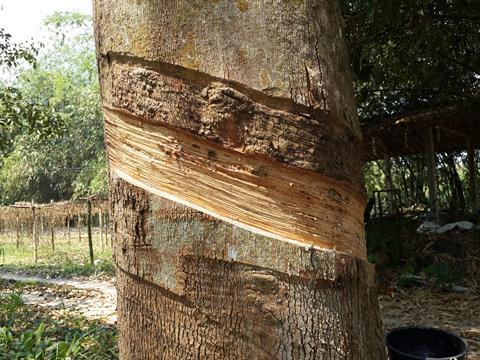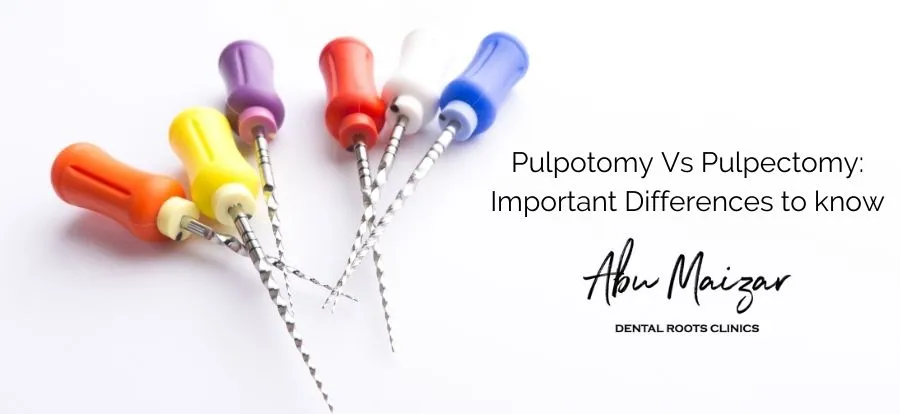abumaizar
administrator | 8 July, 2023
Pulpotomy and pulpectomy (aka root canal treatment or pulp extirpation) are dental procedures that involve the treatment of the pulp (the innermost part of a tooth containing blood vessels and nerves). Here are the key differences between pulpotomy and pulpectomy:
Scope of Treatment
Pulpotomy: It involves the removal of the diseased portion of the dental pulp, specifically the pulp tissue in the crown (top part) of the tooth. It is often performed in cases where the decay or infection has not extended to the root.
Pulpectomy: This procedure is more extensive and involves the complete removal of the pulp tissue from both the crown and the root of the tooth. It is typically performed when the infection has spread to the tooth’s root canals.
Application
Pulpotomy: Commonly performed on baby teeth (deciduous teeth) when decay or infection is limited to the pulp chamber (recently, it’s been used for permanent teeth also).
Pulpectomy: Often done on both primary (baby) and permanent teeth when there is extensive decay or infection affecting the entire pulp, including the root canals.
Objective
Pulpotomy: The goal is to maintain the vitality of the remaining healthy pulp tissue and allow the tooth to continue its normal development until it naturally falls out.
Pulpectomy: The aim is to eliminate infection, relieve pain, and save the tooth by removing all the infected or damaged pulp tissue.
Final Restoration
Pulpotomy: After the diseased pulp is removed, the remaining space is usually filled with a medicated material, and a crown may be placed to protect the tooth.
Pulpectomy: Following the removal of the entire pulp, the root canals are cleaned, disinfected, and filled with a permanent material. A crown is often placed to restore the tooth’s function and strength.
| Feature | Pulpotomy | Pulpectomy |
|---|---|---|
| Scope of Treatment | Removal of diseased portion in the crown | Complete removal of pulp from crown and root |
| Application | Commonly on baby teeth | Common on both baby and permanent teeth |
| Objective | Maintain vitality of remaining pulp | Eliminate infection, relieve pain, save tooth |
| Extent of Pulp Removal | Partial removal | Complete removal |
| Affected Portion | Pulp chamber in the crown | Pulp in both crown and root |
| Final Restoration | Medicated filling, possible crown | Cleaning, disinfection, root canal filling, crown |
| Common Scenarios | Decay or infection limited to the dentine layer of almost reaching the pulp | Extensive decay or infection, reaching the pulp |
| Tooth Development | Allows for normal development until natural loss | Performed to save the tooth |
When to do pulpectomy vs pulpotomy?
When deciding whether to perform a pulpectomy or pulpotomy, your endodontist has to consider many factors.
Pulpectomy is typically recommended when the tooth has irreversible pulpitis, extensive decay, or infection that has spread into the root canals.
It is more commonly performed in permanent teeth.
On the other hand, pulpotomy is often chosen for primary or permanent teeth with reversible pulpitis or shallow decay, where there is a possibility of preserving the remaining healthy pulp.
Additionally, pulpotomy may be preferred when there are limitations in performing a complete pulpectomy due to patient cooperation or anatomical considerations.
The decision between pulpectomy and pulpotomy should be made based on the individual case, as every case has it’s distinct features!
Can pulpectomy be done in primary teeth?

The answer is yes!
Pulpectomy can be performed in primary teeth.
Even though pulpectomy is more commonly associated with permanent teeth, if we have primary teeth with irreversible pulpitis or extensive decay, your endodontist/pediatric dentist can choose to do pulpectomy.
The infected pulp can be completely removed from both the crown and root canals of the primary tooth, and the canals are then filled with an appropriate material.
However, our decision to proceed with pulpectomy in primary teeth depends on the severity of the pulp condition, the child’s ability to cooperate during the procedure, and overall pulp health of this patient!
It is crucial to consult your dentist to determine the most suitable treatment approach.
What is the difference between pulpotomy and pulpectomy for kids?
Kids have primary teeth! And as we mentioned before, we more commonly do pulpotomy more than pulpectomy in these.
However, we have situations where we decide to proceed with pulpectomy despite the fact that the patient is a kid with primary teeth!
And these include that the pulp is severely affected, the kid’s ability to to cooperate with the professionals during the procedure, and the overall oral health of that kid!
Is Gutta Percha used in pulpectomy?
Before we answer this question, Gutta Percha is a rubbery material derived from the sap of the Malaysian tree, It is widely utilized as a root filling material!

And Yes, we commonly use Gutta Percha in pulpectomy, but in permanent teeth!
After the infected pulp is completely removed from both the crown and root canals during a pulpectomy, Gutta Percha is often placed into the canals to seal and fill the space.
This helps to prevent the re-entry of bacteria or any further infection. Gutta Percha is favored due to its biocompatibility, ease of use, and long-term stability as a root canal filling material so it is reliable and helps maintain the integrity of the treated tooth!
However, in primary teeth pulpectomy, we have to use another material that is resorbable in the same rate as the primary tooth, and gutta percha is not resorbable.
What are the stages of pulpectomy?
A pulpectomy procedure involves six main stages, each of them is essential to remove the infected pulp, clean the canals, and seal the tooth efficiently!
While these steps may vary depending on the specific patient’s tooth and the endodontist’s preferences, these are commonly used:
1- Local anesthesia
The first stage involves administering local anesthesia to numb the tooth and surrounding tissues, ensuring a pain-free procedure for our patient.
2- Access cavity preparation
The dentist creates an access opening in the tooth, usually using a dental drill, to gain access to the pulp chamber and root canals.
3- Pulp tissue removal
The infected pulp is carefully removed from its chamber and root canals using specialized instruments such as files and irrigating solutions.
4- Cleaning and shaping
The canals are meticulously cleaned and shaped using the same materials mentioned in the last stage, in order to remove any remaining debris, bacteria, or infected tissue, ensuring proper disinfection.
5- Obturation
Once the canals are ready, they’re filled with a biocompatible material, often Gutta Percha, to seal the canals and prevent reinfection.
6- Coronal Restoration
After the pulpectomy procedure, the access opening in the tooth is filled with a suitable restorative material, such as a crown, to restore the tooth’s structure and functionality.


